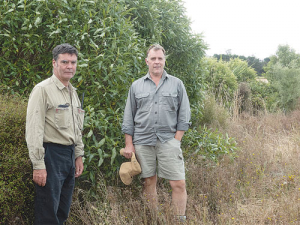Editorial: Sense at last
OPINION: For the first time in many years, a commonsense approach is emerging to balance environmental issues with the need for the nation's primary producers to be able to operate effectively.
 Arable farmer John Evans (left) and forestry and native plant consultant Steve Brailsford at a Better Biodiversity planting site on Evans’ farm at Dorie, near Rakaia. Photo: Rural News Group
Arable farmer John Evans (left) and forestry and native plant consultant Steve Brailsford at a Better Biodiversity planting site on Evans’ farm at Dorie, near Rakaia. Photo: Rural News Group
Mid-Canterbury farmer John Evans is reaping the benefits of native plantings on his farm, in the form of improved pollination and pest control.
“I can’t put a number on it, but I am spending less time and less money on spraying for aphids,” he says.
Evans farms at Dorie, near the coast just south of the Rakaia River, and has five areas devoted to native plantings, established with the help of Tai Tapu native plant nurseryman Steve Brailsford.
One large plot running round three sides of an irrigation pond contains 800 native plants of 36 different species.
Brailsford says they were chosen for being native to the Canterbury Plains in pre-European times, known to harbour insects beneficial for pollination and predator control, and known not to harbour known pests.
The plants needed work in the early years but are now well-established and largely self-regenerating.
Evans, who acknowledges the work of his partner Kai Tegels in the early upkeep, said the only downside is maintenance, but this is far outweighed by the value.
Last year, Evans did not spray a 70ha wheat crop for aphids, yet there was no sign of the aphid-spread virus BYDV.
Evans produces mainly vegetable seed on his 271ha, growing 13 different crops including corn salad, spinach, beet, Chinese cabbage and radish.
He said this year’s Chinese cabbage crop was “just humming” with beneficial native hoverflies and lacewings.
Brailsford described the lacewing as the “vampire of the insect world” for its voracious appetite for pests such as aphids.
The planting was begun in July 2013 as part of a Better Biodiversity project run by Plant and Food scientists Dr Melanie Davidson and Dr Brad Howlett, with the Foundation for Arable Research and with Sustainable Farming Fund support.
Brailsford says while only a few farms joined the Better Biodiversity project, he recommends essentially the same mix of native species to all his Canterbury clients.
“We’re planting about 70,000 plants across Canterbury each season. So we’re incorporating this type of thing into all of our agricultural shelter plantings,” said Brailsford. “You can’t plant a native without having multiple biodiversity benefits.
“Our two main pasture pests -- porina and grass grub -- are actually natives. A whole bunch of native insects will [prey on] them if we provide the habitat for the insects – the native shrubs -- for them to live their lifecycle on,” said Brailsford.
Evans, who chairs the LandWISE group (supporting onfarm R&D mostly in vegetable and arable cropping), said he was attracted to the project initially because of his interest in integrated pest management.
Both men also emphasise the aesthetic value of native plantings, and how they could attract native birdlife. Evans believes that just a few more islands of native plantings across the district would be enough to bring bellbirds back to the plains from Banks Peninsula.
“You know [farmers] get a kick out of going down to shift the cows and seeing fantails all in the shelterbelts,” Brailsford told Rural News.
“You don’t get a lot of biodiversity when you plant one row of pines. But when you put 30 to 40 different natives together there’s a huge amount of biodiversity and wonderful aesthetics.”
Evans said it is a good way to use areas such as irrigation pond berms that were otherwise wasted, unproductive or difficult to manage. “Some might run their rams on it but then they fall in.”
• More on page 34
OPINION: Ministry for Primary Industries' situation outlook for primary industries report (SOPI) makes impressive reading.
Sheep and beef farmers Matt and Kristin Churchward say using artificial intelligence (AI) to spread fertiliser on their sprawling 630ha farm is a game changer for their business.
Commercial fruit and vegetable growers are being encouraged to cast their votes in the Horticulture New Zealand (HortNZ) board directors' election.
A unique discovery by a Palmerston North science company, Biolumic, looks set to revolutionise the value and potential of ryegrass and the secret is the application of ultraviolet (UV) light.
A New Zealand company is redefining the global collagen game by turning New Zealand sheepskin into a world-class health product.
With further extreme weather on the way, ANZ Bank is encouraging farmers and business owners impacted by the recent extreme weather and flooding to seek support if they need it.

OPINION: Dust ups between rural media and PR types aren't unheard of but also aren't common, given part of the…
OPINION: The Hound hears from his canine pals in Southland that an individual's derogatory remarks on social media have left…